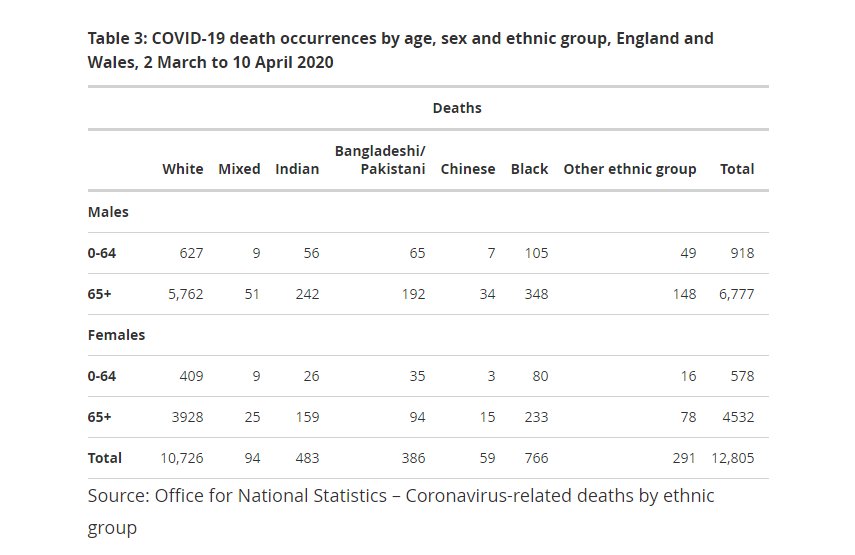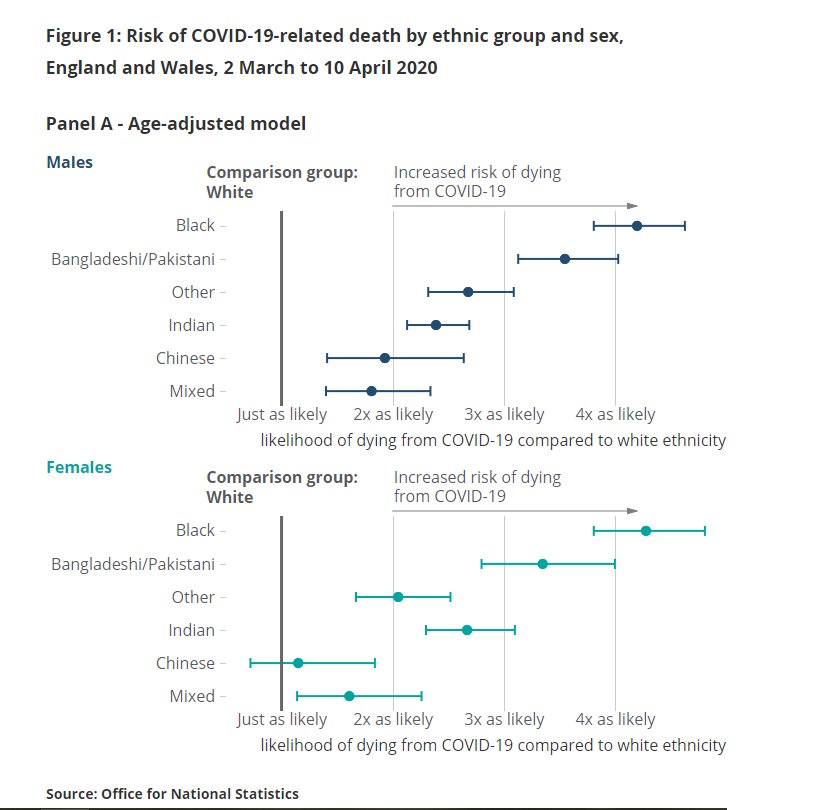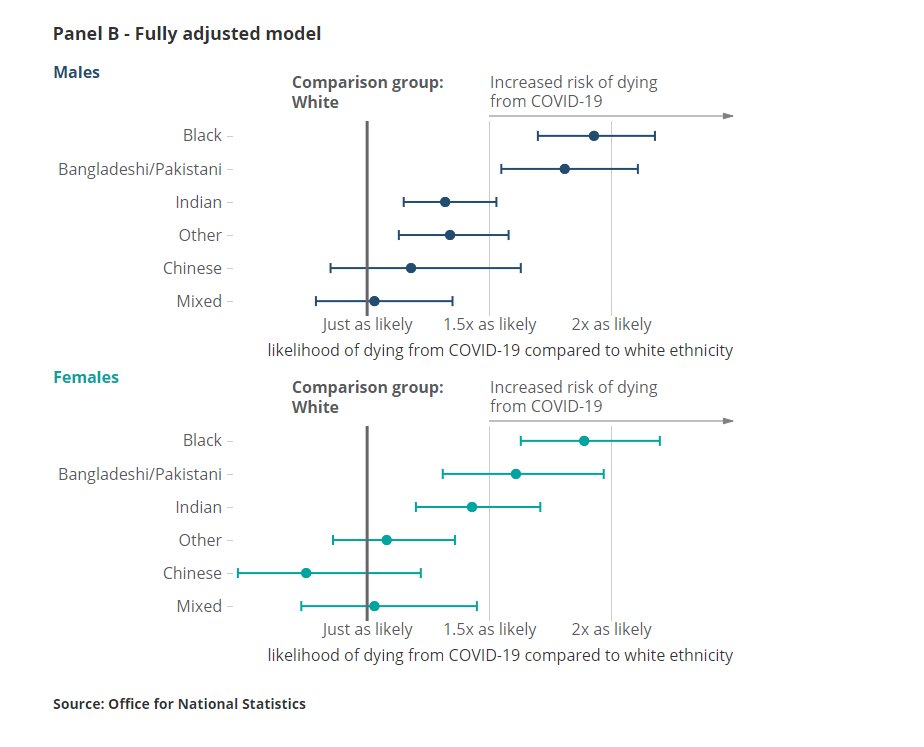ONS stats show BAME people are 4x more likely to die of COVID-19

New analysis released today (7th May 2020) by the Office of National Statistics (ONS) confirms that BAME groups are 4x more likely to die of COVID-19. The analysis has shown that the risk of death involving the coronavirus (COVID-19) among some ethnic groups is significantly higher than that of those of White ethnicity. When taking into account age in the analysis, Black males are 4.2 times more likely to die from a COVID-19-related death and Black females are 4.3 times more likely than White ethnicity males and females. People of Bangladeshi and Pakistani, Indian, and Mixed ethnicities also had statistically significant raised risk of death involving COVID-19 compared with those of White ethnicity.
After taking account of age and other socio-demographic characteristics and measures of self-reported health and disability at the 2011 Census, the risk of a COVID-19-related death for males and females of Black ethnicity reduced to 1.9 times more likely than those of White ethnicity.
Similarly, males in the Bangladeshi and Pakistani ethnic group were 1.8 times more likely to have a COVID-19-related death than White males when age and other socio-demographic characteristics and measures of self-reported health and disability were taken into account; for females, the figure was 1.6 times more likely.
These results show that the difference between ethnic groups in COVID-19 mortality is partly a result of socio-economic disadvantage and other circumstances, but a remaining part of the difference has not yet been explained.
Reacting to the ONS stats, Equality and Human Rights Commission Chief Executive, Rebecca Hilsenrath, said: “These statistics reveal the true impact coronavirus is having on ethnic minority people. Behind every number is a person, with a family left devastated and looking for answers. While the ONS has revealed the numbers, the reasons are less clear. Race inequality is persistent across Britain, with people from ethnic minorities facing disadvantage in their living conditions, access to healthcare and economic opportunities, among other areas, which could be contributing factors. It is this perspective that we are seeking to bring through our participation in the NHS England and Public Health England study into this critical issue.”
The Analysis
The ONS analysis includes deaths involving COVID-19 that occurred between 2 March and 10 April 2020, registered by 17 April.
Ethnicity is not recorded on the death certificate. To enable us to undertake this analysis, deaths involving COVID-19 have been linked to the 2011 Census, which allowed us to ascertain the self-reported ethnicity of the deceased and other demographic factors. Analysis included those aged nine years and above. More details on the data used can be found in Section 7 and in the Technical appendix.
The breakdown of ethnicity we have used in this publication was guided by the number of deaths available for use in analyses and its distribution across ethnic groups. Table 1 shows the breakdown of ethnic groups used. We will repeat this analysis in the future as more data become available; this will include age-standardised mortality rates of deaths involving COVID-19 and, where possible, more detailed breakdowns.
Table 2 shows the number of deaths involving the coronavirus (COVID-19) and their percentage distribution across ethnic groups among the study population. For comparison, figures of hospital deaths involving COVID-19 by ethnicity (Excel, 131KB) published by NHS England, updated up to 21 April, not taking account of more recent updates are also shown. It is important to note that our data differ from NHS England's as we report deaths for both England and Wales, include deaths outside of hospital, and include both confirmed and suspected cases of COVID-19.
Despite these differences in the data, the results are very similar. In the ONS data, the proportion of deaths occurring among those of White ethnicity was 83.8%, while the largest minority ethnic group was Black with 6.0%. Of those for whom ethnicity could be established in the NHS England data, approximately 82.7% were of White ethnicity, and those with Black ethnicity made up 5.7%. The only large difference between the two sources occurs in the category "Other Ethnic Group".
Differences in the risk of dying from COVID-19 across ethnic groups may be related to demographic and socio-economic factors as well as to a person's past health profile. Differences in these characteristics and what they may imply for current circumstances may also be associated with the probability of being infected or the risk of death once infected.
The similarity between these two independent sets of figures supports the reliability of the findings.
Risk of death
The risk of death generally, and specifically death from COVID-19, is closely related to age. After adjusting for age (Panel A), men and women from all ethnic minority groups (except females with Chinese ethnicity) are at greater risk of dying from COVID-19 compared with those of White ethnicity. Black males are 4.2 times more likely to die from COVID-19 than White males, while Black females are 4.3 times more likely to die from COVID-19 than White females. People of Bangladeshi and Pakistani, Indian, and Mixed ethnicities also had statistically significantly raised odds of death compared with those of White ethnicity. For the Chinese ethnic group, we find a raised risk among males but not females. Odds ratios together with their confidence intervals are available in the accompanying data tables.
 To ensure that a broad range of factors were taken into account, we also adjusted for region, rural and urban classification, area deprivation, household composition, socio-economic position, highest qualification held, household tenure, and health or disability in the 2011 Census (Panel B). Therefore, the fully adjusted results show differences in risk between ethnic groups that are specific to those ethnic groups and are not caused by any of the factors listed on which members of the groups might differ.
To ensure that a broad range of factors were taken into account, we also adjusted for region, rural and urban classification, area deprivation, household composition, socio-economic position, highest qualification held, household tenure, and health or disability in the 2011 Census (Panel B). Therefore, the fully adjusted results show differences in risk between ethnic groups that are specific to those ethnic groups and are not caused by any of the factors listed on which members of the groups might differ.
Adjusting for these factors substantially reduces the odds of a death involving COVID-19 relative to those of White ethnicity for all ethnic groups. More information on how the odds ratios change when adjusting for different sets of characteristics can be found in the Technical appendix. Model diagnostics are also available. In the fully adjusted model (Panel B), Black males and females are 1.9 times more likely to die from COVID-19 than the White ethnic group. Males of Bangladeshi and Pakistani ethnicity are 1.8 times more likely to die; for females, odds of death are reduced to 1.6 times more likely. Individuals from the Chinese and Mixed ethnic group have similar risks to those with White ethnicity.
Analysis of COVID-19 deaths by ethnicity in England and Wales
These analyses are based on a new dataset developed by the Office for National Statistics (ONS) that links 2011 Census records to deaths that occurred between 2 March and 10 April 2020 registered by death registrations up to 17 April 2020, with deaths being added on a weekly basis. This represents a large dataset with which to examine mortality variations by ethnicity during a short time frame, benefiting from assignment of ethnicity at a census and then following individuals for death events occurring during the coronavirus (COVID-19) pandemic. Such a dataset reduces the risk of introducing numerator and denominator biases that can be problematic in analyses using unlinked data. More details on how the census and deaths records were linked can be found in the Technical appendix.
Deaths were defined using the International Classification of Diseases, 10th Revision (ICD-10). Deaths involving COVID-19 include those with an underlying cause, or any mention, of ICD-10 codes U07.1 (COVID-19, virus identified) or U07.2 (COVID-19, virus not identified).
To view the full analysis visit https://www.ons.gov.uk





